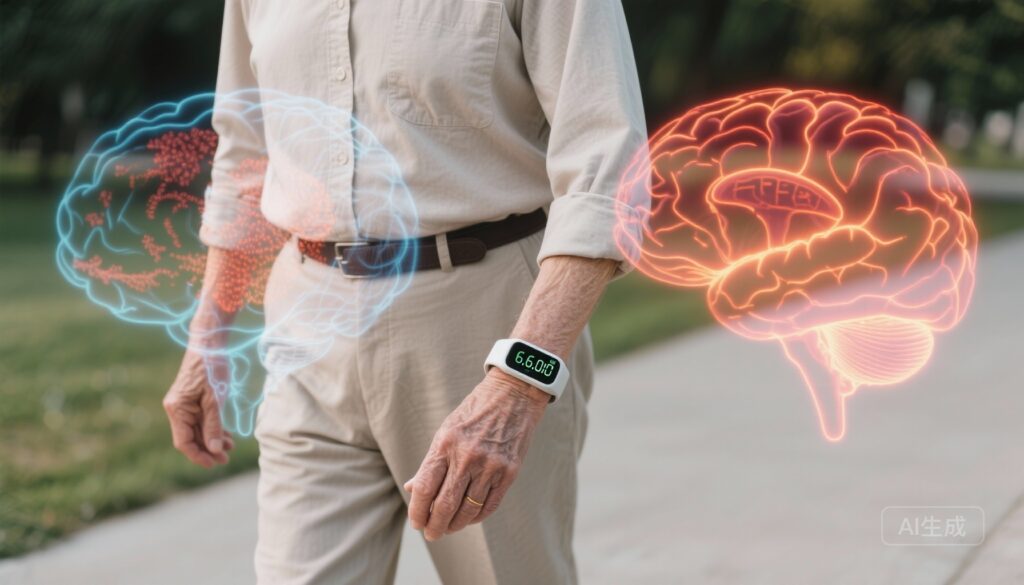Highlights
– In cognitively unimpaired older adults with elevated amyloid, higher pedometer-measured daily steps were associated with slower cognitive and functional decline.
– The protective association was not explained by differences in baseline or longitudinal amyloid burden, but by slower accumulation of inferior temporal tau on PET; tau accumulation significantly mediated the cognitive benefits.
– Dose–response analyses indicated a curvilinear relationship: benefits plateaued at a moderate activity level (~5,001–7,500 steps/day), suggesting an attainable target for sedentary older adults.
Background and disease burden
Alzheimer’s disease (AD) is increasingly conceptualized as a long preclinical phase in which core pathologies—amyloid-beta (Aβ) and tau—accumulate years before measurable cognitive impairment. Prevention efforts therefore focus on modifiable risk factors that could alter disease trajectory when applied early. Physical inactivity is a well-recognized, population-level risk factor for dementia; observational studies and randomized multidomain trials suggest physical activity can improve cognitive outcomes and cardiovascular risk profiles, both of which are relevant to dementia prevention (Livingston et al., 2020; Ngandu et al., 2015). However, mechanistic links between habitual physical activity and the molecular pathologies of AD in humans—especially tau accumulation—have been incompletely characterized, constraining trial design and translational strategies.
Study design and population
The study by Yau et al. (Nat Med, 2025) examined cognitively unimpaired older adults enrolled in longitudinal observational cohorts who had baseline amyloid PET imaging and prospective assessments including tau PET, serial cognitive and functional measures, and pedometer-measured step counts. Key design elements included objective measurement of habitual physical activity via pedometer-derived daily step counts, stratification by baseline amyloid status (elevated vs not elevated), longitudinal tau PET in anatomic regions relevant to AD (inferior temporal cortex highlighted), and mediation analyses to test whether tau dynamics explained associations between activity and clinical decline. Endpoints comprised longitudinal change in cognition and functional status, rate of regional tau accumulation, and amyloid burden cross-sectionally and over time.
Key findings
Association of activity with clinical trajectories
Among participants with elevated baseline amyloid (preclinical AD), higher average daily step counts were associated with slower longitudinal cognitive and functional decline. The effect was specific to the amyloid-positive subgroup; in participants without elevated amyloid there was no consistent protective association. Effect sizes were reported as clinically meaningful in the amyloid-positive group, with higher activity linked to attenuated decline on global and domain-specific cognitive measures as well as slower functional deterioration on validated scales.
Relationship to amyloid burden
Contrary to a simple ‘‘less amyloid explains benefit’’ model, baseline physical activity did not correlate with lower amyloid PET signal cross-sectionally, nor did higher activity predict slower longitudinal amyloid accumulation. Thus, the observed clinical associations do not appear to operate through modifying amyloid burden within the time frame of the study.
Activity and tau accumulation: a crucial link
The most striking mechanistic insight was the relationship between activity and tau dynamics. Higher daily step counts were associated with slower accumulation of tau in the inferior temporal cortex—a region implicated in early symptomatic progression and in cognitive decline. Mediation analysis indicated that slower inferior temporal tau accumulation accounted for a significant proportion of the association between higher activity and slower cognitive decline, supporting a pathway in which physical activity attenuates tau spread/growth and thereby preserves cognition.
Dose–response and actionable thresholds
Analyses of dose–response revealed a curvilinear relation: cognitive and tau-related benefits increased across the lower to moderate activity range but reached a plateau at approximately 5,001–7,500 steps per day. Above this range incremental benefit was limited, suggesting a moderate, attainable target for interventions aimed at older sedentary individuals. These findings are clinically useful because they provide a concrete daily-step goal that is feasible for many older adults and may help structure public health and trial recruitment messages.
Sensitivity analyses and robustness
Results were robust to adjustment for demographic covariates and cardiovascular risk factors, and sensitivity analyses addressing potential reverse causation (i.e., declining preclinical cognition leading to lower activity) were reported. Nonetheless, residual confounding and measurement limitations (pedometer vs. multi-sensor devices; single-region tau focus) are acknowledged by the authors.
Expert commentary and interpretation
These data strengthen the biological plausibility that habitual physical activity may slow progression in preclinical AD via effects on tauopathy rather than amyloid clearance. The inferior temporal cortex is a logical region to show early tau-related signal that correlates with cognition, and the finding that tau accumulation mediates the protective effect is an important advance. Mechanistically, exercise could influence tau through a number of non–mutually exclusive pathways: reduced neuroinflammation, improved cerebrovascular function and perfusion, enhanced glymphatic clearance during sleep, upregulation of neurotrophic factors (e.g., BDNF), and improved metabolic resilience (Erickson et al., 2011). Animal models also suggest exercise attenuates tau phosphorylation and spread, lending translational support.
Clinically, providing an evidence-based, moderate step-count target (~5k–7.5k/day) is highly actionable and could motivate primary prevention efforts. These findings align with prior multidomain prevention trials (e.g., FINGER) that included physical activity as a component and showed cognitive benefit in at-risk older adults (Ngandu et al., 2015). What is new here is the molecular link to tau PET dynamics in humans.
Limitations and counterpoints
Important limitations temper interpretation. The study design is observational, so causality cannot be definitively established despite mediation modeling and sensitivity checks. Residual confounding by health status, socioeconomic factors, or unmeasured lifestyle variables remains possible. Pedometer-derived step counts capture ambulatory activity but not resistance training, balance work, or non-step moderate-to-vigorous activities (e.g., cycling, swimming), and device placement and adherence can introduce noise. The temporal window of amyloid and tau change is long; longer follow-up may reveal different relationships with amyloid. Finally, cohorts enriched for research volunteers often have selective demographics, which can limit generalizability to diverse populations.
Implications for prevention trials and clinical practice
For trialists, these findings suggest high-yield strategies: (1) recruit cognitively unimpaired, amyloid-positive, sedentary older adults to maximize the chance of detecting an effect on tau accumulation and clinical outcomes; (2) use objective step-count targets and wearable monitoring to quantify adherence and dose; (3) consider tau PET as a mechanistic and intermediate outcome that may be more sensitive than amyloid PET to lifestyle intervention effects over typical trial durations; and (4) power studies to detect clinically meaningful changes in cognition mediated by tau dynamics.
For clinicians and public-health practitioners, counseling older adults—particularly those at elevated AD biomarker risk—about increasing daily steps to a moderate level (roughly 5,000–7,500 steps/day) represents a low-cost, low-risk recommendation with plausible benefit for cognitive aging and cardiovascular health. Messaging that frames steps as an attainable, measurable goal may improve adherence among sedentary patients.
Next research steps
Key next steps include randomized controlled trials that randomize amyloid-positive, sedentary older adults to step-count interventions (behavioral coaching, digital feedback, structured walking programs) versus usual care, with tau PET and cognitive/functional endpoints. Trials should incorporate diverse populations, longer follow-up to evaluate durability of effects, and complementary biomarker measures (neuroinflammation markers, cerebrovascular imaging, sleep metrics). Dose-finding studies could refine optimal targets and test whether combining aerobic steps with resistance training yields additive effects on tau and cognition.
Conclusion
Yau et al. provide compelling, biologically plausible evidence that habitual physical activity—measured objectively as daily steps—is associated with slower tau accumulation in an AD-relevant brain region and with attenuated cognitive and functional decline in amyloid-positive, cognitively unimpaired older adults. The absence of an association with amyloid burden and the mediation by tau suggest that exercise-related benefits in preclinical AD operate through tau-modifying or resilience pathways. The identification of a moderate, achievable step-count range as a plateau for benefit (≈5,000–7,500 steps/day) offers a pragmatic target for prevention strategies and trial design. While causality remains to be proven in randomized trials, these findings support prioritizing physical inactivity in prevention efforts and in the design of biomarker-informed intervention studies.
Funding and clinicaltrials.gov
Funding sources were reported in the original publication (Yau et al., 2025). No specific clinicaltrials.gov identifier applies to this observational analysis; future interventional trials should be registered prospectively.
References
1. Yau WW, Kirn DR, Rabin JS, Properzi MJ, Schultz AP, Shirzadi Z, Palmgren K, Matos P, Maa C, Pruzin JJ, Schultz SA, Buckley RF, Rentz DM, Johnson KA, Sperling RA, Chhatwal JP. Physical activity as a modifiable risk factor in preclinical Alzheimer’s disease. Nat Med. 2025 Nov 3. doi: 10.1038/s41591-025-03955-6. Epub ahead of print. PMID: 41184638.
2. Livingston G, Huntley J, Sommerlad A, Ames D, Ballard C, Banerjee S, Brayne C, Burns A, Cohen-Mansfield J, Cooper C, Costafreda S, de Mendonça Lima CA, Dening T, Ferri CP, Francis P, Gallacher J, Ganguli M, Henley W, Huang Y, Jacova C, Jellinger KA, Keene J, Lang I, Larson E, Lee L, Liperoti R, Logroscino G, Lopez OL, Love S, et al. Dementia prevention, intervention, and care: 2020 report of the Lancet Commission. Lancet. 2020;396(10248):413–446.
3. Ngandu T, Lehtisalo J, Solomon A, Levälahti E, Ahtiluoto S, Antikainen R, Bäckman L, Hänninen T, Jula A, Laatikainen T, Lindström J, Mangialasche F, Paajanen T, Rauramaa R, Stigsdotter-Neely A, Strandberg T, Tuomilehto J, Soininen H, Kivipelto M. A 2-year multidomain intervention of diet, exercise, cognitive training, and vascular risk monitoring versus control to prevent cognitive decline in at-risk elderly (FINGER): a randomized controlled trial. Lancet. 2015;385(9984):2255–2263.
4. Erickson KI, Voss MW, Prakash RS, Basak C, Szabo A, Chaddock L, Kim JS, Heo S, Alves H, White SM, Wojcicki TR, Mailey EL, Vieira VJ, Martin SA, Pence BD, Woods JA, McAuley E, Kramer AF. Exercise training increases size of hippocampus and improves memory. Proc Natl Acad Sci U S A. 2011;108(7):3017–3022.
5. Jack CR Jr, Bennett DA, Blennow K, Carrillo MC, Dunn B, Haeberlein SB, Holtzman DM, Jagust W, Jessen F, Karlawish J, Liu E, Molinuevo JL, Montine T, Phelps CH, Rankin KP, Rowe CC, Scheltens P, Siemers E, Snyder HM, Sperling R; contributors. NIA-AA Research Framework: Toward a biological definition of Alzheimer’s disease. Alzheimers Dement. 2018 Apr;14(4):535–562.



